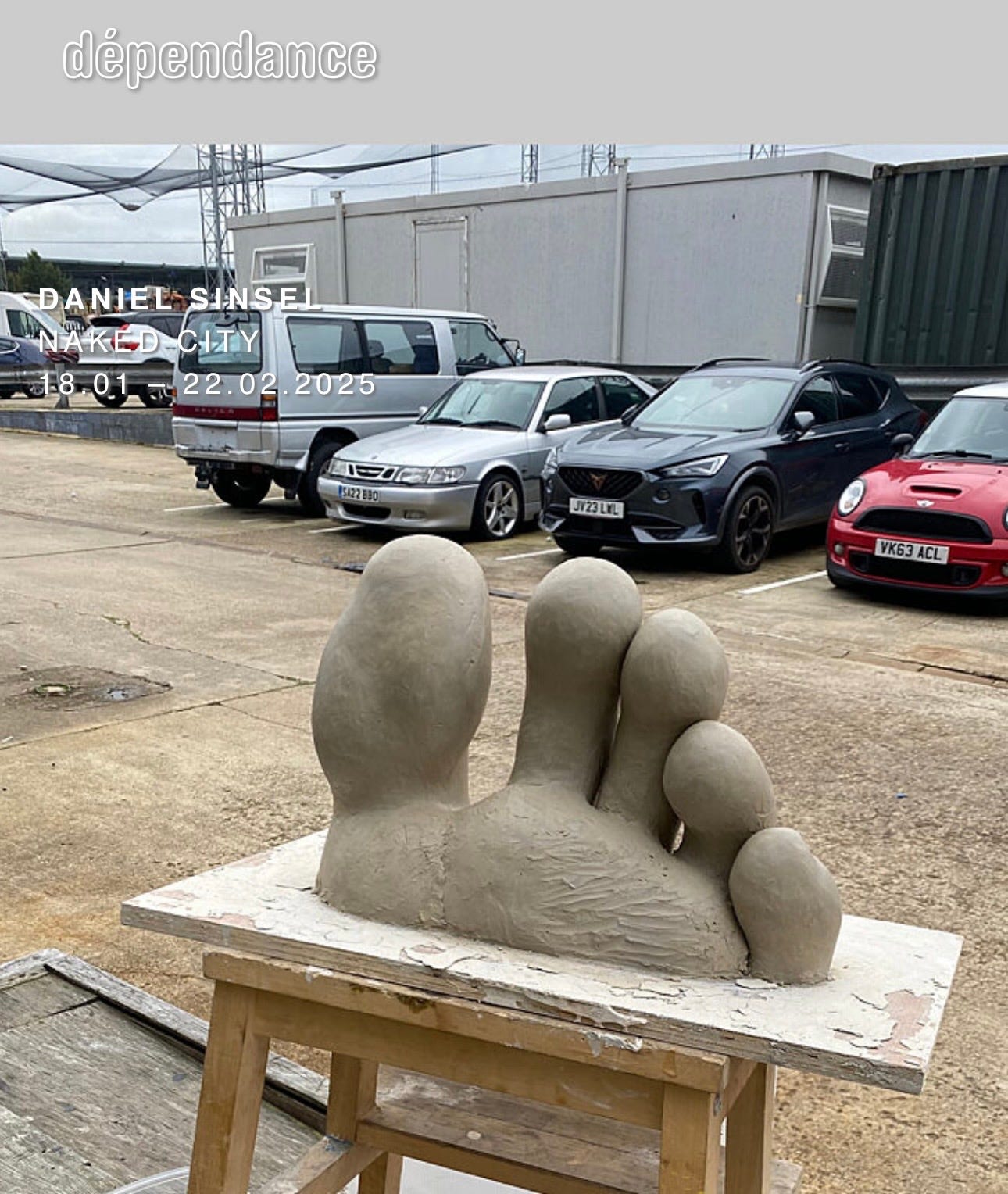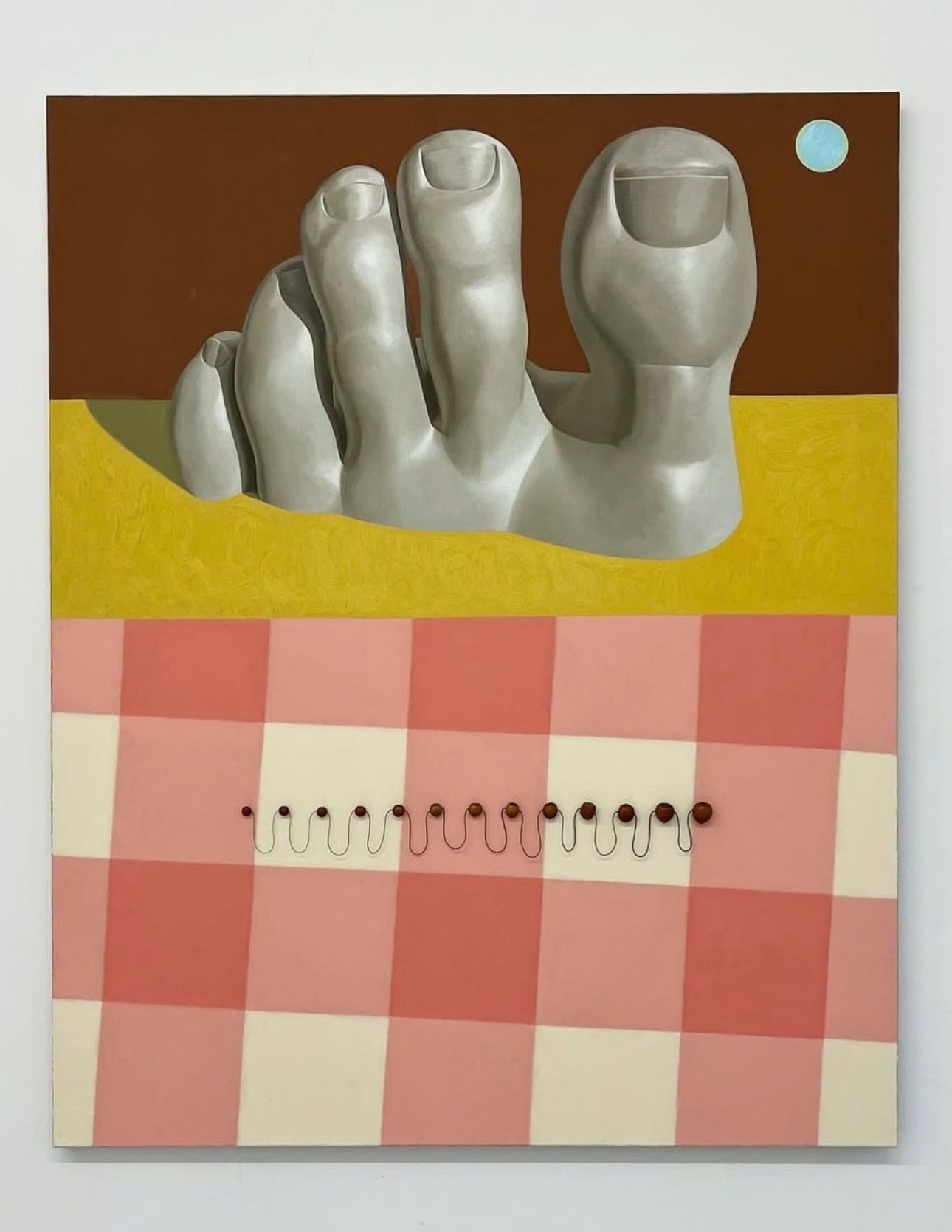Naked City
Exhibition text for Daniel Sinsel’s show at Dépendance in Brussels
Naked City
Daniel Sinsel
The artist Ken Price said, ‘Skill is the highway to the unconscious’. Is there a consonance between the mind’s vaudevillian hidden chambers and Daniel’s painted trickery? His analogue sleight of hand does have a certain Victorian stage magic that psychoanalysis also wields. The inverse of this interpretation, as reported by some neuroscientists, is that the mind is ‘flat’ – a statistical prediction machine. No great ziggurats are buried in the silt of the psyche; just nodes in a horizontal probability space, trying to minimise prediction error.
Daniel’s work is a chimera of these two poles: the anticipatory and the mythopoetic. His paintings reconfigure the world, rather than deconstruct it; they synthesise and regenerate. Drawing serves as a relatively minor foundation, more prominent is a linguistic or semiotic structure, akin to what a poet or filmmaker might employ. His compositions suggest scene cuts or stanzas: recursive visual similes rhyming in harmony.
One of the great strengths of Daniel’s work is that it is not passive. His art is a cuckoo; it presents an air of ease and naturalism that is historically familiar. Once inside the nest and past our defences, it goes to work, contradicting and moulding all the predictive and passive assumptions we use to navigate the visual world. In this regard, Daniel is a realist – not a surrealist. He elucidates that what we consider ‘real’ is a contingent simulation, bridging the correspondences between the world and the brain. In Daniel’s work, it is not the mind’s models that validate his painted representations – his representations reshape the mind.
This is all achieved with adroit skill. To be skilled is to have fluency and restraint. Being able to use painting, bricolage and sculpting techniques without cloying prejudice or attachment affords a precise utility. Each component of Daniel’s work has an almost autonomous functionality, honed to guide both the audience and the artist himself. Because of this, we encounter both the artist’s unguarded curiosity and his reluctance to ingratiate the viewer with schlock autobiography. We do not feel oppressed by his obsessive control but rather alleviated by it. In eudaemonic openness, we acquiesce to the works’ siren-like flirtation. This manipulation doesn’t feel subversive or malevolent, and this is perhaps its eroticism. It invites the viewer to participate; to evaporate into its glinting verisimilitude.
Desire reveals the impotence of free will – unveiling the sovereignty of the genetic information strung through every cell in the human organism. The universality of eros, with its blind striving, produces arbitrary fixations. Through its rosy lens, a myriad of perceptual stimuli spontaneously glows with attraction. Daniel’s paintings act as a transparent container which holds the ether of sex. In its atmosphere, a seamless multitude of fetish artifacts form a population. Pristine sherbet origami and suburban cyber-acid gradients are blended with Motown record sleeves. A gargantuan classical foot seeds clouds with a papyrus umbellifer, perfumed with the quality of sandy ice lolly wrappers fading past a high watermark. This all coheres; it even feels sensible and obvious. We are integrated quickly into this semi-flatland: spatial dimension, linguistic habits and visual conventions oscillate like ferromagnetic slime.
The audience participates in this abstract sexuality of the visual cortex, which is severed from genital or reproductive efficacy. In the stasis of an image, there cannot be duration. The arc of striving – then release – occurs simultaneously and is entwined within the pictorial composition. We sense the luminous and crystalline eroticism of the young adolescent, without habits or well-worn fixations: more botanical than animal.
Through the works in ‘Naked City’ we detect that the artist is searching for a distinct homeliness, or polity, to tether these ephemeral loops of sensation. Off camera, we sense the vernacular town of a children’s picture book or a Kafka short story: plaster towers rise up from a subterranean channel of toes, like the fever dream of Aldo Rossi. Outside of the city walls, there is nothing but a foggy boundary, as in a video game: the rendering stops. At times, it feels as if the audience is embedded in the de-Sitter space of a Peewee Herman TV set – or glued, like a planed wood shaving, into a Venetian picnic blanket – whilst hazelnut sperm wriggle across its grid. This has a slightly queasy familiarity: a purgatory? Any half-serious introspection leads to this netherworld feeling; that the obvious and the common sensical are straw dogs and can blow over easily. For Daniel, it is straw dogs all the way down. It is the relations – not the objects – that are what really counts.
Daniel Sinsel
Untitled
2024
oil on canvas, nutshells, silk
124 x 100 x 6 cm
48 7/8 x 39 3/8 x 2 3/8 inch




